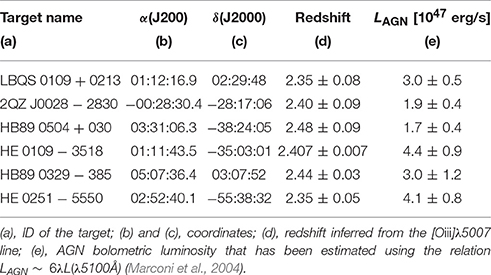- 1Cavendish Laboratory, University of Cambridge, Cambridge, United Kingdom
- 2Kavli Institute for Cosmology, University of Cambridge, Cambridge, United Kingdom
Galaxy evolution is likely to be shaped by negative feedback from active galactic nuclei (AGN). In the whole range of redshifts and luminosities studied so far, galaxies hosting an AGN frequently show fast and extended outflows consisting in both ionized and molecular gas. Such outflows could potentially quench the start formation within the host galaxy, but a clear evidence of negative feedback in action is still missing. Hereby I will analyse integral-field spectroscopic data for six quasars at z ~ 2.4 obtained with SINFONI in the H- and K-band. All the quasars show [OIII]λ5007 line detection of fast, extended outflows. Also, the high signal-to-noise SINFONI observations allow the identification of faint narrow Hα emission (FWHM < 500 km/s), which is spatially extended and associated with star formation in the host galaxy. On paper fast outflows are spatially anti-correlated with star-formation powered emission, i.e., star formation is suppressed in the area affected by the outflow. Nonetheless as narrow, spatially-extended Hα emission, indicating star formation rates of at least 50–100 M⊙ yr−1, has been detected, either AGN feedback is not affecting the whole host galaxy, or star formation is completely quenched only by several feedback episodes. On the other hand, a positive feedback scenario, supported by narrow emission in Hα extending along the edges of the outflow cone, suggests that galaxy-wide outflows could also have a twofold role in the evolution of the host galaxy. Finally, I will present CO(3-2) ALMA data for three out of the six QSOs observed with SINFONI. Flux maps obtained for the CO(3-2) transition suggest that molecular gas within the host galaxy is swept away by fast winds. A negative-feedback scenario is supported by the inferred molecular gas mass in all three objects, which is significantly below what observed in non-active main-sequence galaxies at high-z.
1. Introduction
Negative feedback from accreting black holes (BH) is considered a fundamental physical process in galaxy evolution: it is believed to inhibit the excessive growth of massive galaxies and to explain the steep stellar mass function at its high end, to explain the existence of the “red and dead” elliptical galaxies, and to provide a connection between the supermassive BH growth and host galaxy evolution (e.g., Hopkins et al., 2006). Feedback from accreting BH, i.e., from an AGN, takes the form of a fast outflow accelerated by the AGN radiation pressure which pushes gas away from the host galaxy, suppressing both star formation activity and BH accretion (e.g., Fabian, 2012). The recent discoveries of massive, powerful molecular outflows on galactic scales have partially confirmed the AGN feedback scenario by showing that the observed outflow rates are larger than the star formation rates and that they can expel the gas from the host galaxy on very short time scales (Cicone et al., 2014, and references therein). Recent ALMA CO observations have also revealed massive molecular outflows in nearby Seyfert 2 galaxies with a outflow rate of an order of magnitude higher than the SFR (Combes et al., 2013; García-Burillo et al., 2014). However, although AGN-driven outflows have been detected in several AGN, we are still missing the “smoking gun” evidence that they are effectively quenching star formation: what we are seeking is a proof that star formation is indeed inhibited in the galaxy regions swept by the outflows.
Here, I report the results obtained by Carniani et al. (2015, 2016, 2017): the characterization of AGN-driven ionized outflows in a sample of quasars at z ~ 2.4 and their interaction with the host galaxies.
2. AGN-Driven Outflows at z ~ 2.4
2.1. Sample Selection and Observations
Most of following results are based on seeing limited (~0.6′′) integral field observations of six luminous (LAGN ~ 1047 erg/s) quasars (QSOs) at z ~ 2.4 with SINFONI at VLT, aimed at mapping the kinematics of the AGN ionized gas by using the [OIII]λ5007 emission line (Carniani et al., 2015). The six QSOs have been drawn from the samples of Netzer et al. (2004), Shemmer et al. (2004), and Marziani et al. (2009). The selected sample is characterized by large [OIII]λ5007 equivalent width (>10Å) and H-band magnitude <16.5 mag. The redshift of the sample has been selected to increase the chances of detecting QSO-feedback, since QSOs activity is expected to reach its peak a z ~ 2−3. The QSOs are listed in Table 1.
2.2. Ionized Outflow Properties
The [OIII]λ5007 line profiles in the integrated spectra extracted from the QSO nuclei show prominent blueshifted wings (FWHM ~1,000–1,500 km/s) that suggests the presence of fast gas approaching along the line-of-sight. A kinematical analysis also reveals that the optical line is spatially resolved in five sources and its emission is extended up to ~2 kpc. The morphology of the [OIII]λ5007 velocity maps are characterized by conical blue-shifted region that is completely different from the typical “spider” diagram of a simple rotating disc. The shape of the [OIII]λ5007 velocity maps and the asymmetric line profiles support the presence of ionized outflowing gas with velocities >300 km/s in our QSOs. Given the observed velocities, the outflows can only be ascribed to the AGN.
The spatially resolved observations enable to infer the mass (Mo), radius (vo) and velocity (Ro) of the outflowing material and, then, to calculate the outflow mass rate (Ṁo) as follow
The broad wings of the [OIII]λ5007 line yield to a ionized mass outflow rate of ~10–700 M⊙ yr−1. Figure 1 shows the outflow velocity and outflow mass rate as a function of the AGN luminosity. Comparing this results with those obtained from previous studies in literature (Greene et al., 2012; Cicone et al., 2014; Harrison et al., 2014; Sun et al., 2014; Brusa et al., 2015; Cresci et al., 2015; Feruglio et al., 2015), we clearly observe a relation between outflow properties and AGN luminosities (LAGN). The velocity and mass rate of the fast gas increase with the LAGN supporting the scenario that these outflows are AGN-driven and their properties depend on the AGN activity.
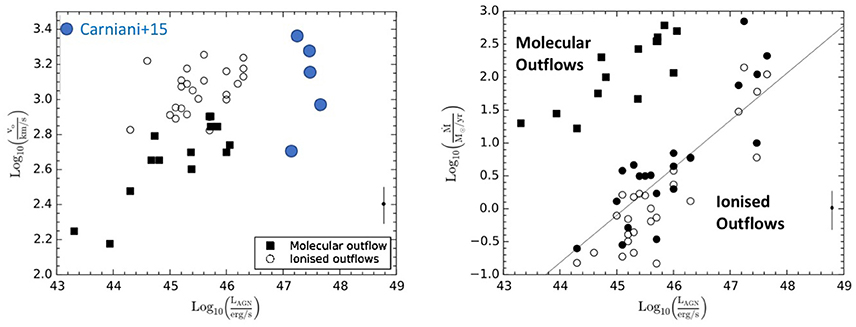
Figure 1. Outflow velocity (left) and mass rate (right) vs. AGN luminosity (Figure is an adaption from Carniani et al., 2015). Open circles represent the estimates of ionized outflows obtained from [OIII]λ5007 line, while the filled marks are based on Hβ. A representative error bar is shown at right in each plot and it corresponds to an average error of ±0.2 dex for the outflow velocity and ±0.3 dex for the outflow mass rate. The errors take also in account for uncertainties due to projection effects. The best-fit Ṁo − LAGN relation for the ionized outflows is indicated in the panel with a black line. Square points indicate velocities and outflow rate inferred from molecular outflows. Carniani, A&A, 580, A102, 2015, reproduced with permission© ESO.
The molecular and ionized outflow seems to follow two different Ṁo–LAGN relations: mass rate estimated in molecular outflows is ~50 higher than that estimated in ionized outflows. This discrepancy may indicate that most of the gas in the outflow is in molecular gas phase, while the ionized gas content is <10% of the total fast gas. Similar results have recently confirmed also in the work by Fiore et al. (2017).
2.3. Star Formation in the QSO Host Galaxies
In three QSOs of the selected sample (2QZ J0028–2830, HB89 0329−385 and LBQS 0109 + 0213) we have also detected narrow (FWHM < 500 km/s) and spatially diffuse emission in [OIII]λ5007 and Hα. The non-detection of the corresponding narrow [NII] component exclude excitation by the AGN radiation, since the optical line ratio is well consistent with gas excited in HII region. The detection of the narrow Hα component indicates ongoing star-formation in the AGN host galaxies with SFR ~50–100 M⊙ yr−1 (assuming the Log(SFR/M⊙ yr−1) = Log(LHα/erg s−1) − 41.27 relation by Kennicutt and Evans 2012).
More intriguingly, the presence of the ionized outflows appears to be spatially anti-correlated with the emission of the narrow components indicating that the star formation is suppressed and/or prevented in the outflow region (Figure 2). A similar scenario has also been observed by Cresci et al. (2015) in a radio-quiet QSO at z = 1.7. Even in this case, the star-formation activity is absent in the AGN-driven outflow, while star-formation regions are clearly visible at the edges of the outflow cone.
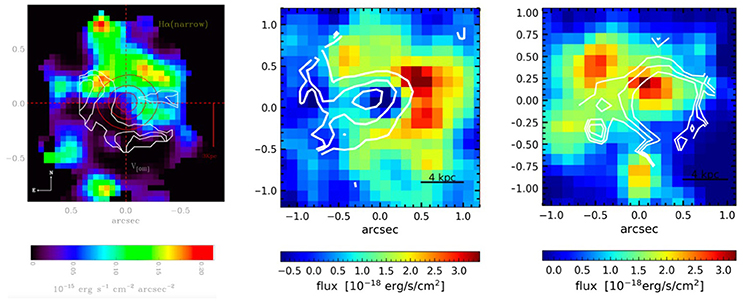
Figure 2. Intensity map of narrow Hα (left and middle) emission and [OIII]λ5007 (right) emission for the three quasars showing ionized outflow anti-correlated with the star formation: 2QZ J0028–2830 from Cano-Díaz et al. (2012), HB89 0329−385 and LBQS 0109 + 0213 from Carniani et al. (2015, 2016). The stamps are 1′′ × 1′′, 1.2′′ × 1.2′′, and 1.2′′ × 1.2′′, respectively for the three sources. The white contours in both maps trace the blue shifted [OIII]λ5007 velocities of the broad component tracing the ionized outflow. The contours represent the velocities −390, −360, and 330 km/s for 2QZ J0028–2830, −150, 100, −50 km/s for HB89 0329 − 38, and 300, 275, and 250 km/s for LBQS 0109 + 0213. Credit: Cano-Díaz, A&A, 537, L8, 2012, reproduced with permission© ESO; Carniani, A&A, 591, 28C, 2016, reproduced with permission© ESO.
All these observations may be interpreted as evidences for AGN negative feedback in action, since star formation is quenched in the regions where the fast outflows interact with the host galaxy. However, optical emission lines, such as [OIII]λ5007 and Hα, can be affected by differential extinction effects and current SINFONI observations are not sufficient to rule out the possibility that the lack of star formation emission in the outflow region is caused by dust obscuration. In this regards, these QSOs were proposed as targets of two ALMA programs in Cycle 2 and 3 with the goal to observe the CO(3-2) line and map the distribution of the cold molecular gas in the host galaxies. Indeed, since the CO emission line is a good tracer of the cold molecular gas, which is the main fuel of star formation activity, and it is not affected by dust obscuration, the spatially distribution of molecular gas may support (or confute) negative feedback scenario in the QSOs.
2.4. Molecular Gas
The three QSOs, showing star formation spatially anti-correlated to ionized outflows, have been observed with ALMA in the band at ~3 mm, where CO(3-2) is redshifted. Although the targets have similar properties and the continuum emission at ~3 mm (~0.9 mm rest frame) is visible in all of them, CO(3-2) transition at the systemic velocity of the sources is detectable only in one out of three QSOs (LBQS 0109 + 0213).
Both redshift and line width of the molecular line are consistent, within the errors, with those of the narrow [OIII]λ5007 and Hα component observed with SINFONI and discussed in the previous section. As expected, the CO(3-2) surface brightness appears to be asymmetrically distributed around the nucleus, similarly to the flux map of the narrow optical lines, indicating that the emission from molecular gas is absent or faint in the outflow region (Figure 3). Since the CO line is not affected by dust attenuation, ALMA observations support the scenario in which AGN-driven fast winds clear out ionized and molecular gas from the host galaxy, and quench star formation at least in the outflow region.
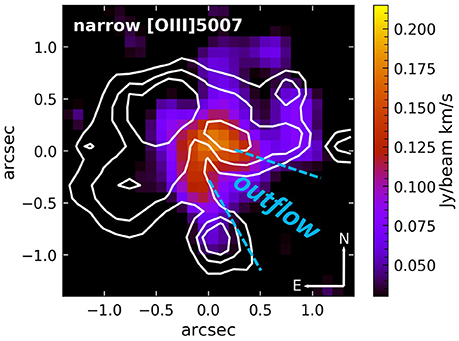
Figure 3. The color background image CO(3-2) flux map of LBQS0109, while white contours indicate the narrow [OIII]λ5007 emission tracing star-formation emission in the host galaxy. Contours are in steps of 1σ = 0.4 × 10−18 erg/s/cm2, starting at 2σ. The blue dashed line indicates the direction of the AGN-driven outflow inferred from the velocity map of the broad components. Star-formation and molecular gas emission is faint/absent in the outflow region. The figure is an adaptation from Carniani et al. (2017). Credit: Carniani, A&A, 605, A105, 2017, reproduced with permission© ESO.
Assuming a / ratio of 1 (Carilli and Walter, 2013; Carniani et al., 2017) infer a molecular gas mass for LBQS 0109 + 0213 of Mgas = 0.8–4 × 1010 M⊙ depending on the assumed conversion factor between CO(1-0) luminosity and gas mass (αCO = 0.8–4 M⊙/K km/s pc2; Bolatto et al. 2013). For the other two QSOs, non-detections yield to an upper limit on the molecular mass of Mgas < 0.2 − 1.2 × 1010 for 2QZ J0028–2830 and Mgas < 0.2 − 1.0 × 1010 for HB89 0329–385. The inferred molecular masses (or upper limits) are clearly below what observed in main-sequence galaxies with similar redshift and SFR, while they are comparable to molecular masses observed in active galaxies (Figure 4). Indeed, the depletion timescale, which is the time required for the outflow to remove the gas from the galaxy (τdep = Mgas/SFR), estimated for each QSOs of our sample (τdep < 800 Myr) is consistent to those observed in high—z submillimetre galaxies (SMGs) and obscured QSOs at z = 1.5 − 2.5 (Banerji et al., 2017; Kakkad et al., 2017).
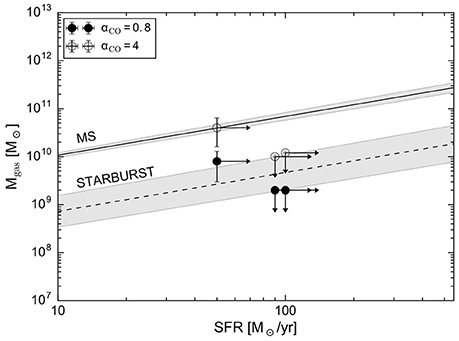
Figure 4. Mgas-SFR plane from Carniani et al. (2017). The solid black line is the best-fit relation for main sequence galaxies and the dashed indicate the relation for the starburst galaxies (Sargent et al., 2014). Filled black circles corresponds to the three QSOs assuming a αCO = 0.8 M⊙/K km/s pc2 and open circles are derived supposing a αCO = 4 M⊙/K km/s pc2. Credit: Carniani, A&A, 605, A105, 2017, reproduced with permission© ESO.
The low depletion timescale may yield to the conclusion that the three QSOs host galaxies are still in a starburst phase and the AGN-driven outflows do not influence the star formation activity. However, the CO, [OIII]λ5007 and Hα maps clearly exhibits a cavity in the outflow region leading to the conclusion that a fraction of molecular gas has been removed from the galaxy by the outflow (negative feedback), but, at the same time, we have star-formation on-going in the rest of the galaxy. This star-formation could be also enhanced by the outflow pressure itself (positive feedback), as expected by recent simulation (e.g., Zubovas and Bourne, 2017). Unfortunately, the sensitivity of current ALMA observations is not sufficient to reveal the presence outflowing molecular gas in LBQS 0109 + 0213 and we cannot evaluate the fraction of the gas that has been already removed due the AGN-driven outflow.
3. Summary and Conclusions
Carniani et al. (2015, 2016, 2017) carried out seeing-limited, near-IR integral-field spectroscopic observations with SINFONI in H- and K-band of six high-luminosity (Lbol > 1047 erg/s) QSOs at z ~ 2.4.
• Five objects show a broad [OIII]λ5007 line revealing spatially extended ionized fast gas with velocities >500 km/s and outflow mass rates of ~ 10 – 700 M⊙ yr−1.
• Velocity, mass rate, kinetic energy, momentum mass rate of the ionized outflows seem to correlate with the observed AGN luminosities, indicating the these outflows are AGN-driven.
• The comparison between the relation mass outflow rate and AGN luminosity obtained from molecular and ionized outflow suggests that outflow masses are mainly dominated by molecular gas.
• In three QSOs, we detect narrow [OIII]λ5007 and Hα emission tracing quiescent gas in the host galaxy and excited by star formation activity. The emission of these narrow components is absent and/or faint in the outflow regions supporting a clear evidence of negative-feedback in action. However, the high SFR (>50 M⊙ yr−1) inferred from the narrow Hα line indicates the star formation is halted only in the outflow regions.
• ALMA observations have revealed CO(3-2) emission at the systemic velocity of the host galaxy only in one QSO and the flux map of the molecular line is similar to those obtained from the narrow optical lines. The lack of CO(3-2) emission in the outflow region indicates that both ionized and molecular gas have been removed by AGN-driven outflow
SINFONI and ALMA observations hint that AGN feedback is not able to prevent completely star formation in QSO host galaxies. On the other hand, theses results suggest that several explosive events are necessary to accomplish the suppression. This research would benefit from a larger sample with similar AGN luminosities and redshift in order to reach more reliable results. In addition, new deeper ALMA observations may reveal the presence of molecular outflow in these QSOs and evaluate what fraction of the total molecular gas content has been swiped out from the host galaxy.
Author Contributions
The author confirms being the sole contributor of this work and approved it for publication.
Conflict of Interest Statement
The author declares that the research was conducted in the absence of any commercial or financial relationships that could be construed as a potential conflict of interest.
Acknowledgments
I thank A. Marconi, R. Maiolino, C. Cicone, G. Cresci, C. Feruglio, M. Brusa, M. Cano-Díaz, V. Mainieri, B. Balmaverde, R. Schneider, F. Fiore, A. Ferrara, F. La Franca, S. Gallerani, F. Mannucci, T. Nagao, H. Netzer, E. Piconcelli, A. Comastri, E. Sani, L. Testi, G. Risaliti, and O. Shemmer for the useful comments and discussions. SC acknowledges financial support from the Science and Technology Facilities Council (STFC). We thank the reviewers for a very quick and thoughtful report.
References
Banerji, M., Carilli, C. L., Jones, G., Wagg, J., McMahon, R. G., Hewett, P. C., et al. (2017). The discovery of gas-rich, dusty starbursts in luminous reddened quasars at z ~ 2.5 with ALMA. Month. Notices R. Astron. Soc. 465, 4390–4405. doi: 10.1093/mnras/stw3019
Bolatto, A. D., Wolfire, M., and Leroy, A. K. (2013). The CO-to-H2 conversion factor. Annu. Rev. Astron. Astrophys. 51, 207–268. doi: 10.1146/annurev-astro-082812-140944
Brusa, M., Bongiorno, A., Cresci, G., Perna, M., Marconi, A., Mainieri, V., et al. (2015). X-shooter reveals powerful outflows in z.5 X-ray selected obscured quasi-stellar objects. Month. Notices R. Astron. Soc. 446, 2394–2417. doi: 10.1093/mnras/stu2117
Cano-Díaz, M., Maiolino, R., Marconi, A., Netzer, H., Shemmer, O., and Cresci, G. (2012). Observational evidence of quasar feedback quenching star formation at high redshift. Astron. Astrophys. 537:L8. doi: 10.1051/0004-6361/201118358
Carilli, C. L., and Walter, F. (2013). Cool Gas in High-Redshift Galaxies. Annu. Rev. Astron. Astrophys. 51, 105–161. doi: 10.1146/annurev-astro-082812-140953
Carniani, S., Marconi, A., Maiolino, R., Balmaverde, B., Brusa, M., Cano-Díaz, M., et al. (2015). Ionised outflows in z ~ 2.4 quasar host galaxies. Astron. Astrophys. 580:A102. doi: 10.1051/0004-6361/201526557
Carniani, S., Marconi, A., Maiolino, R., Balmaverde, B., Brusa, M., Cano-Díaz, M., et al. (2016). Fast outflows and star formation quenching in quasar host galaxies. Astron. Astrophys. 591:A28. doi: 10.1051/0004-6361/201528037
Carniani, S., Marconi, A., Maiolino, R., Feruglio, C., Brusa, M., Cresci, G., et al. (2017). AGN feedback on molecular gas reservoirs in quasars at z ~ 2.4. Astron. Astrophys. 605:A105. doi: 10.1051/0004-6361/201730672
Cicone, C., Maiolino, R., Sturm, E., Graciá-Carpio, J., Feruglio, C., Neri, R., et al. (2014). Massive molecular outflows and evidence for AGN feedback from CO observations. Astron. Astrophys. 562:A21. doi: 10.1051/0004-6361/201322464
Combes, F., García-Burillo, S., Casasola, V., Hunt, L., Krips, M., Baker, A. J., et al. (2013). ALMA observations of feeding and feedback in nearby Seyfert galaxies: an AGN-driven outflow in NGC 1433. Astron. Astrophys. 558:A124. doi: 10.1051/0004-6361/201322288
Cresci, G., Mainieri, V., Brusa, M., Marconi, A., Perna, M., Mannucci, F., et al. (2015). Blowin' in the Wind: Both “Negative” and “Positive” Feedback in an Obscured High-z Quasar. Astrophys. J. 799:82. doi: 10.1088/0004-637X/799/1/82
Fabian, A. C. (2012). Observational evidence of active galactic nuclei feedback. Annu. Rev. Astron. Astrophys. 50, 455–489. doi: 10.1146/annurev-astro-081811-125521
Feruglio, C., Fiore, F., Carniani, S., Piconcelli, E., Zappacosta, L., Bongiorno, A., et al. (2015). The multi-phase winds of Markarian 231: from the hot, nuclear, ultra-fast wind to the galaxy-scale, molecular outflow. Astron. Astrophys. 583:A99. doi: 10.1051/0004-6361/201526020
Fiore, F., Feruglio, C., Shankar, F., Bischetti, M., Bongiorno, A., Brusa, M., et al. (2017). AGN wind scaling relations and the co-evolution of black holes and galaxies. Astron. Astrophys. 601:A143. doi: 10.1051/0004-6361/201629478
García-Burillo, S., Combes, F., Usero, A., Aalto, S., Krips, M., Viti, S., et al. (2014). Molecular line emission in NGC 1068 imaged with ALMA. I. An AGN-driven outflow in the dense molecular gas. Astron. Astrophys. 567:A125. doi: 10.1051/0004-6361/201423843
Greene, J. E., Zakamska, N. L., and Smith, P. S. (2012). A spectacular outflow in an obscured quasar. Astrophys. J. 746:86. doi: 10.1088/0004-637X/746/1/86
Harrison, C. M., Alexander, D. M., Mullaney, J. R., and Swinbank, A. M. (2014). Kiloparsec-scale outflows are prevalent among luminous AGN: outflows and feedback in the context of the overall AGN population. MNRAS 441, 3306–3347. doi: 10.1093/mnras/stu515
Hopkins, P. F., Somerville, R. S., Hernquist, L., Cox, T. J., Robertson, B., and Li, Y. (2006). The relation between quasar and merging galaxy luminosity functions and the merger-driven star formation history of the universe. Astrophys. J. 652, 864–888. doi: 10.1086/508503
Kakkad, D., Mainieri, V., Brusa, M., Padovani, P., Carniani, S., Feruglio, C., et al. (2017). ALMA observations of cold molecular gas in AGN hosts at z = 1.5 - evidence of AGN feedback? Month. Notices R. Astron. Soc. 468, 4205–4215. doi: 10.1093/mnras/stx726
Kennicutt, R. C., and Evans, N. J. (2012). Star formation in the milky way and nearby galaxies. Annu. Rev. Astron. Astrophys. 50, 531–608. doi: 10.1146/annurev-astro-081811-125610
Marconi, A., Risaliti, G., Gilli, R., Hunt, L. K., Maiolino, R., and Salvati, M. (2004). Local supermassive black holes, relics of active galactic nuclei and the X-ray background. Month. Notices R. Astron. Soc. 351, 169–185. doi: 10.1111/j.1365-2966.2004.07765.x
Marziani, P., Sulentic, J. W., Stirpe, G. M., Zamfir, S., and Calvani, M. (2009). VLT/ISAAC spectra of the Hβ region in intermediate-redshift quasars. III. Hβ broad-line profile analysis and inferences about BLR structure. Astron. Astrophys. 495, 83–112. doi: 10.1051/0004-6361:200810764
Netzer, H., Shemmer, O., Maiolino, R., Oliva, E., Croom, S., Corbett, E., et al. (2004). Near-infrared spectroscopy of high-redshift active galactic nuclei. II. Disappearing narrow-line regions and the role of accretion. Astrophys. J. 614, 558–567. doi: 10.1086/423608
Sargent, M. T., Daddi, E., Béthermin, M., Aussel, H., Magdis, G., Hwang, H. S., et al. (2014). Regularity underlying complexity: a redshift-independent description of the continuous variation of galaxy-scale molecular gas properties in the mass-star formation rate plane. Astrophys. J. 793:19. doi: 10.1088/0004-637X/793/1/19
Shemmer, O., Netzer, H., Maiolino, R., Oliva, E., Croom, S., Corbett, E., et al. (2004). Near-infrared spectroscopy of high-redshift active galactic nuclei. I. A metallicity-accretion rate relationship. Astrophys. J. 614, 547–557. doi: 10.1086/423607
Sun, A.-L., Greene, J. E., Zakamska, N. L., and Nesvadba, N. P. H. (2014). ALMA observations of a candidate molecular outflow in an obscured quasar. Astrophys. J. 790:160. doi: 10.1088/0004-637X/790/2/160
Keywords: QSO, high-redshifts galaxies, galaxy evolution, AGN negative-feedback, AGN positive-feedback, ALMA, molecular gas, emission lines
Citation: Carniani S (2017) Star Formation Quenching in Quasar Host Galaxies. Front. Astron. Space Sci. 4:24. doi: 10.3389/fspas.2017.00024
Received: 23 August 2017; Accepted: 02 October 2017;
Published: 16 October 2017.
Edited by:
Ascensión Del Olmo, Consejo Superior de Investigaciones Científicas (CSIC), SpainReviewed by:
Daniela Bettoni, Osservatorio Astronomico di Padova (INAF), ItalyViviana Casasola, Arcetri Astrophysical Observatory, Italy
Copyright © 2017 Carniani. This is an open-access article distributed under the terms of the Creative Commons Attribution License (CC BY). The use, distribution or reproduction in other forums is permitted, provided the original author(s) or licensor are credited and that the original publication in this journal is cited, in accordance with accepted academic practice. No use, distribution or reproduction is permitted which does not comply with these terms.
*Correspondence: Stefano Carniani, c2M4ODhAbXJhby5jYW0uYWMudWs=
 Stefano Carniani
Stefano Carniani